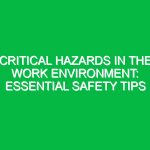Introduction to Spotter Safety at Work
Hello team! Today, we’re gathering for a toolbox talk focused on an essential aspect of our daily operations: Spotter Safety at Work. As you know, safety is our top priority, and understanding the role of spotters in our work Environment is critical in preventing accidents and ensuring a safe workspace. By the end of this discussion, you will have a clearer understanding of spotter safety protocols, the responsibilities involved, and how we can work together to maintain a safe environment for everyone.
Understanding Spotter Safety
Spotter safety involves the practices and protocols that safeguard both the spotter and the workers they are assisting. A spotter is responsible for guiding equipment operators and ensuring the safety of those around them. This role is vital in environments where visibility might be limited or where heavy machinery is in Operation.
The Importance of Spotter Safety at Work
Why is spotter safety so crucial? According to statistics, many workplace accidents occur due to miscommunication or lack of awareness of surroundings. When spotters are not adequately trained or aware of their responsibilities, the risks of accidents increase significantly. By prioritizing spotter safety, we reduce the likelihood of injuries and create a more efficient work environment.
Key Responsibilities of a Spotter
To ensure effective spotter safety, it’s essential to understand the key responsibilities involved:
- Communication: Spotters must maintain clear and constant communication with equipment operators, using hand signals or radios as needed.
- Awareness: Spotters need to be aware of their surroundings, including the location of other workers, equipment, and potential Hazards.
- Positioning: Spotters should position themselves where they can see the operator and the area of operation, ensuring they have a clear line of sight.
- Emergency Procedures: Spotters should be familiar with emergency procedures and ready to act if a situation arises.
Identifying Potential Hazards
Every work environment presents its own set of hazards. Here are some common risks associated with operations requiring spotters:
- Blind spots: Heavy machinery often has blind spots, making it difficult for operators to see pedestrians and other equipment.
- Noise: High noise levels can impede communication, making it difficult for spotters and operators to communicate effectively.
- Environmental factors: Weather conditions, uneven terrain, and poor lighting can all impact safety.
- Distraction: Workers may become distracted, leading to miscommunication or accidents.
Best Practices for Spotter Safety at Work
To mitigate these risks, implementing Best Practices is crucial. Here are some effective strategies for ensuring spotter safety:
1. Training and Certification
All spotters should undergo proper Training and certification. This training should cover communication techniques, hazard recognition, and emergency procedures. Regular refresher courses can help keep skills sharp and ensure everyone is up-to-date on safety protocols.
2. Establish Clear Communication Protocols
Effective communication is the backbone of spotter safety. Establishing clear signals—both verbal and non-verbal—can significantly reduce the risk of accidents. For instance, using standardized hand signals can help bridge communication gaps, especially in noisy environments.
3. Conduct Pre-Operation Briefings
Before beginning any task, conduct a pre-operation briefing. This discussion should include an overview of the job, a review of safety protocols, and a discussion of potential hazards. Encourage everyone to voice their concerns or ask questions during this time.
4. Maintain Situational Awareness
Spotters must be vigilant and aware of their surroundings at all times. This includes monitoring the movement of equipment, the actions of other workers, and any changes in the environment. Encourage spotters to communicate any concerns immediately.
5. Use Proper Personal Protective Equipment (PPE)
Wearing appropriate PPE is vital for all workers, including spotters. Ensure that spotters have access to and wear necessary gear, such as hard hats, reflective vests, gloves, and safety footwear.
6. Implement a Buddy System
Encouraging a buddy system can enhance spotter safety. Pairing spotters with another worker can provide additional eyes and ears, improving communication and awareness on-site.
Real-Life Scenarios and Lessons Learned
Let’s take a moment to consider a hypothetical scenario: imagine a construction site where a crane is lifting heavy materials. The operator relies on a spotter to guide them, yet the spotter is distracted by nearby conversations. As the crane moves, the operator cannot see a worker who is behind the load. Without effective communication and focus, this situation could lead to a severe accident.
This scenario emphasizes the critical need for spotters to be fully engaged and attentive at all times. Regularly reviewing such situations during our toolbox talks can help reinforce safety awareness and prevent future incidents.
Engagement and Discussion
Now, let’s open the floor for discussion. Here are a few questions to consider:
- What challenges do you face regarding spotter safety at work?
- Can anyone share an experience where effective spotting made a difference?
- What additional training do you think could improve our spotter safety practices?
Regulations and Standards
Understanding the Regulations and standards related to spotter safety is crucial for compliance and safety. The Occupational Safety and Health Administration (OSHA) has specific guidelines detailing the roles and responsibilities of spotters. Familiarizing yourself with these regulations not only helps maintain compliance but also enhances overall safety.
Additionally, our company policies may have specific requirements tailored to our work environment. Always refer to these guidelines whenever you’re unsure about procedures or responsibilities.
Conclusion
In conclusion, ensuring Spotter Safety at Work is a shared responsibility that requires constant vigilance, effective communication, and adherence to safety protocols. By implementing the Best Practices we discussed today, we can create a safer work environment for everyone.
Thank you all for your attention and commitment to safety. Remember, your role as a spotter is vital, and your efforts contribute to the well-being of your teammates and the success of our operations. Let’s continue to prioritize safety in everything we do!


